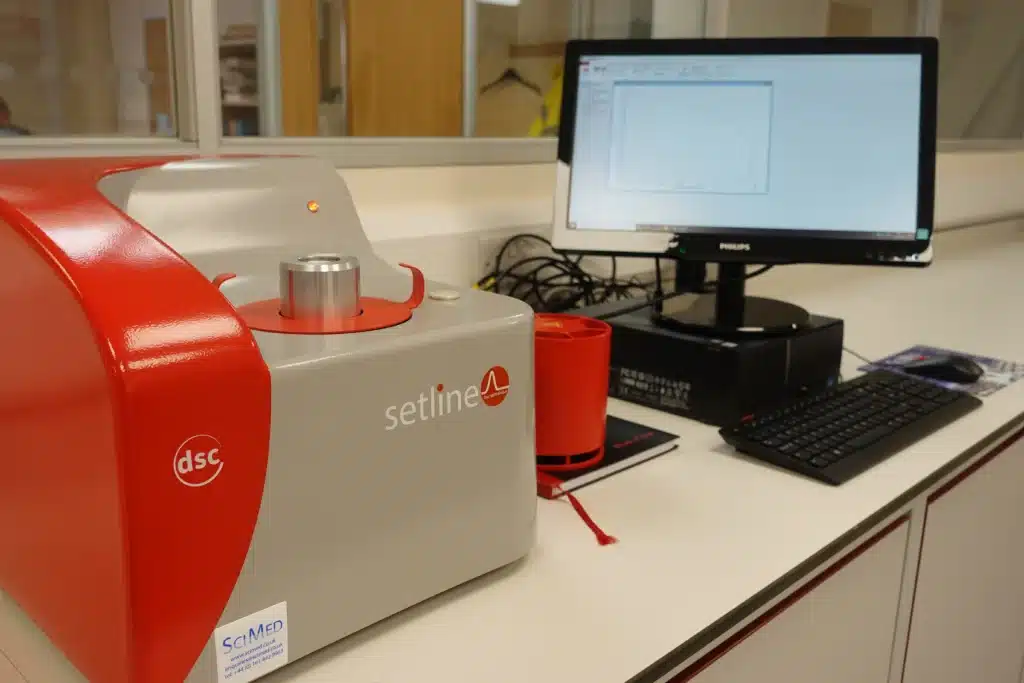
Our Solutions: Testing
Our laboratories generate test data on chemical reaction hazards and their exothermic reaction potential.
We undertake the following tests:
We also offer a range of Thermal Stability Testing services.
Discover our range of CRH screening tests below and get in touch for a free consultation today.
ASTM E 537-12
The Differential Scanning Calorimetry test is conducted to assess the presence of enthalpic changes, decomposition reactions and to approximate both the temperature of initiation and enthalpies (heats) of solids, liquids or slurries.
This test in conducted by measuring the heat flow (Δq) associated with the change of enthalpy. An absolute temperature (T) of the test material or reference to the average temperature of elapsed time is also taken. The test sample is examined before the test is undertaken. The material and a thermally inert reference material are then placed into isolated containers.
Both the testing sample and the reference material are then simultaneously heated at a controlled rate of 2 K/min to 20 K/min under an equilibrated atmosphere. A record of heat flow as a function of temperature is then established. When the sample experiences a transformation that involves a change of enthalpy indicated by a departure from the established baseline. These temperature changes are then detailed and recorded.
The Differential Scanning Calorimetry (DSC) test can detect potentially hazardous reactions from volatile chemicals while estimating the time at which a hazardous reaction may occur. The DSC can also be used as an early-stage test for detecting the potentially hazardous thermal components of uncharacterized materials.
The Advanced Reactive System Screening Tool (ARSST) is an adiabatic calorimeter batch reactor tool that is used to quickly identify potential chemical hazards in processes.
It consists of a well instrumented pressure vessel that holds a spherical glass test cell that can heat a 10ml sample at a uniform rate of up to 400°C. The reaction mixture, magnetic stirrer and thermocouple are then introduced to this cell. The pressure inside the vessel is then measured by a pressure transducer. Due to the unique heating method by a wraparound heater, the sample is kept in a quasi-adiabatic mode and no heat is lost to surroundings occurs. Typical data outputs can include the following:
Rate of pressure rise
Heat of reaction
Heat of mixing
Total adiabatic temperature rise
Onset temperature
Tempering temperature
Self-accelerating decomposition temperature
Time to maximum rate (induction time profile)
ASTM E 1981-98
The Accelerating Rate Calorimetry test is conducted to assess the time, temperature and pressure data of a material as it undergoes a physicochemical change under near adiabatic conditions.
A sample is placed in a reaction container and positioned in the calorimeter. This is then heated to an optimum environmental temperature until the test sample has reached an equilibrium. During this time, evidence of an exothermic reaction is monitored. If the environmental rate of temperature rise is first exceeded, then an exotherm has usually occurred. If not, the system temperature is raised slightly, and the test begins again. This cycle is repeated until an exotherm has been detected or the upper temperature limit of the test has been reached.
Time, temperature, and pressure data are recorded at temperature intervals as a function of time. This data can then be used to the time rates of changes of pressure and temperature. This data can be used to calculate a time-to-maximum rate, obtain kinetic parameters for non-autocatalytic exothermic reactions and to calculate an adiabatic temperature rise / heat of reaction.
The Accelerating Rate Calorimetry (ARC) test can directly simulate and predict thermal and pressure events in the processing, storage, and shipping of potentially hazardous chemicals. The ARC can also be used to investigate the effects of catalyst, inhibitors, initiators, reaction atmospheres, materials of construction and agitation.
The Carius tube apparatus is used as a small-scale screening tool for thermal stability and the determination of thermal runaway reactions. It is primarily undertaken to investigate exothermic activity and gas generation. The Carius tube can also aid in the detection of exothermic activities such as onset temperatures. It can also identify the pressure effects of permanent gas generation.
The Carius tube apparatus works by placing approximately 10 grams of a test material in a heavy-walled sealed glass tube and then placing it in an oven. The oven temperature is then increased at a controlled rate (typically 0.5 K/min). The temperature and pressure of the test cell are then detailed and recorded to assess the thermal stability of the sample upon heating.
The Carius tube apparatus can be used to detect the onset temperature of an exotherm and any concurrent gas evolution, while simultaneously obtaining an estimate of their energy and volume. It can also be used to examine the delayed onset of reactions and to estimate the rate at which gas evolution has been detected. The Carius Tube test can quickly identify thermal regions of interest (exothermic events, structural changes, permanent gas generation), which can then in turn be investigated in more detail using adiabatic or more precise techniques. The Carius Tube is often run as a screening test complimentary to Differential Scanning Calorimetry (DSC), as it provides the valuable pressure data not available in the DSC.
Calorimetric techniques are usually employed for measurements that are based on heat flow and are completed under controlled laboratory conditions. These techniques are then used in conjunction with thermal stability data to create a detailed understanding of behavioral limits for potential deviations to normal processes.
For chemical reaction processes that have runaway potential, an understanding of thermodynamics, kinetics and gas generation/vapor pressure of the process should provide a basis for evaluating the consequences of deviation from normal process conditions.
At Sigma-HSE, we provide a range of calorimetric solutions to aid you in identifying and analyzing chemical reaction hazards. Our calorimetric solutions provide you with actionable insights to protect business, people, workplace and the environment against potential deviations to your processes.
Discover our range of calorimetry tests below and get in touch for a free consultation today.
The Reaction Calorimeter is designed for measuring heat generated, chemical conversions and heat transfer under process conditions. The Reaction Calorimeter allows process chemistry and safety engineers to optimize processes under safe conditions while determining critical process parameters to reduce the risk of failures at scale.
The adiabatic calorimeter test provides data for relief system design, safe scale-up of chemical processes and changes to process ingredients. Safe process design requires knowledge of chemical reaction rates, character and energy release; all of which can be obtained from a low phi-factor adiabatic calorimeter.
Heat Flow Calorimetry provides reaction information early in the development process to improve the chemical workflow. This chemical test data can be used to characterize, optimize and understand process parameters in a controlled, accurate and reproducible environment.
Chemical reaction hazards testing and analysis aims to prevent potential accidents and inadvertent incidents caused by industrial related chemical reactions. Our comprehensive testing aims to restrict and/or exclude potentially dangerous materials or energy that may result in catastrophe.
Sigma-HSE’s chemical reaction hazards testing lab offers comprehensive standard and custom testing packages to aid you in identifying chemical reaction hazards and other related risks.
Can’t find the tests you need?
From Differential Scanning Calorimetry to the Advanced Reactive System Screening Tool, Sigma-HSE is your single solution provider for a variety of chemical reaction hazards analysis and chemical testing services. Our dedicated team of experts are committed to helping you ensure and maintain compliance.
Receive quick and accurate data in just a few simple steps
Get in touch with one of our experts so we can learn more about your specific requirements. We’ll then generate and send you a customized quote.
Prepare your samples and ship them to one of our global laboratories.
Once we’ve received your samples, we’ll begin testing and analyzing. We’ll then create and send you a custom in-depth report with actionable insights.
If you need support after receiving your report, our after-sales support team will be on hand to assist you with any questions you may have.
Testing for chemical reaction hazards at your facility is an important aspect of chemical process safety compliance. Learn more about how we can assist you today.

Are you visiting Sigma-HSE from outside your region? Visit your regional site for more relevant process safety solutions.